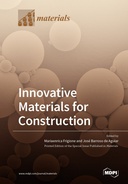Explore

Innovative Materials for Construction
0 Ungluers have
Faved this Work
Login to Fave
Most of the typical materials employed in today’s constructions present limitations, especially concerning their durability, in either common or severe environmental conditions, and their impact on the environment. In response to these issues, academic and industrial efforts around the world have been devoted to developing new smart materials that can provide efficient alternatives, improve the energy efficiency of buildings, or can upgrade, repair, or protect existing infrastructures. Different and wide technological innovations are, therefore, quickly fostering advancements in the field of construction materials. A new generation of materials (bricks, cement, coatings, concrete, FRP, glass, masonry, mortars, nano-materials, PCM, polymers, steel, wood, etc.) is gaining a prominent position in modern building technology, since they can overcome various limits and flaws of conventional materials employed in constructions, without neglecting the smart applications of pioneering materials in ancient constructions and historic buildings. Even though the adoption of innovative materials in the construction field has been a successful route in achieving enhanced performance, or even new and unexpected characteristics, some issues have not been completely solved. On top of them, the cost/performance ratio of novel solutions, since their introduction must be convenient, without compromising quality. Other concerns are related to their sustainability, with eco-friendly options, possibly exploiting recycled materials or by-products from other productions, being the most desirable solution. Finally, the use of materials or systems that are unconventional in this field raises the need to update or develop new specifications and standards. This special issue aims at providing a platform for discussing open issues, challenges, and achievements related to innovative materials proposed for the construction industry.
This book is included in DOAB.
Why read this book? Have your say.
You must be logged in to comment.
Rights Information
Are you the author or publisher of this work? If so, you can claim it as yours by registering as an Unglue.it rights holder.Downloads
This work has been downloaded 127 times via unglue.it ebook links.
- 127 - pdf (CC BY) at Unglue.it.
Keywords
- 27Al MAS NMR
- aircraft load-bearing structures
- analytic hierarchy process (AHP)
- Bacteria
- biocement
- biocementation
- bitumen emulsion
- bond strength
- building construction
- Ca7ZrAl6O18
- Cement
- cement hydration
- Circular Economy
- cold in-place recycling
- composite material
- compressive strength
- concrete headed GFRP rebar
- concrete system form
- construction
- cultural heritage
- development length
- durability
- energy fracture
- equilibrium path
- finite elements method
- flexural strength
- freezing and thawing
- glass fiber-reinforced polymer (GFRP) rebar
- gypsum
- hydraulic lime
- immobilization of radioactive Sr
- isogrid
- jute
- ladle furnace slag
- material property
- material selection
- mechanical characterization
- Mechanical properties
- MICP
- microbially induced calcium carbonate precipitation
- mortars
- n/a
- natural plant fiber
- NHL
- nonlinear numerical analyses
- phase change material (PCM)
- phase-change materials (PCM)
- precast concrete deck
- project performance
- quasi-brittle material
- reclaimed asphalt pavements
- Reference, information & interdisciplinary subjects
- refractories
- Research & information: general
- retrofitting
- shrinkage-reducing agent
- simple compressive strength
- spacing factor
- splitting tensile strength
- Sr-rich (Sr,C)3AH6
- Stability
- strengthening
- sustainable materials for buildings
- Technology, engineering, agriculture
- Technology: general issues
- Thermal energy storage
- thermal energy storage (TES)
- Thermal properties
- three-point bending test
- ultra-high-performance concrete (UHPC)
- ureolytic bacteria
- waste
Links
DOI: 10.3390/books978-3-0365-0167-3Editions

